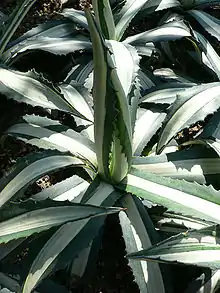
Cutan is one of two waxy biopolymers which occur in the cuticle of some plants. The other and better-known polymer is cutin. Cutan is believed to be a hydrocarbon polymer, whereas cutin is a polyester, but the structure and synthesis of cutan are not yet fully understood. Cutan is not present in as many plants as once thought; for instance it is absent in Ginkgo.[1]
Cutan was first detected as a non-saponifiable component, resistant to de-esterification by alkaline hydrolysis, that increases in amount in cuticles of some species such as Clivia miniata as they reach maturity, apparently replacing the cutin secreted in the early stages of cuticle development.[2][3] Evidence that cutan is a hydrocarbon polymer comes from the fact that its flash pyrolysis products are a characteristic homologous series of paired alkanes and alkenes, and through 13C-NMR analysis of present-day and fossil plants.[3]
Cutan's preservation potential is much greater than that of cutin.[1] Despite this, the low proportion of cutan found in fossilized cuticle shows that it is probably not the cause for the widespread preservation of cuticle in the fossil record.[4]
References
- 1 2 Briggs, D. E. G. (1999). "Molecular taphonomy of animal and plant cuticles: selective preservation and diagenesis". Philosophical Transactions of the Royal Society B: Biological Sciences. 354 (1379): 7–17. doi:10.1098/rstb.1999.0356. PMC 1692454.
- ↑ Schmidt, H.W.; Schönherr, J. (1982). "Development of plant cuticles: occurrence and role of non-ester bonds in cutin of Clivia miniata Reg. leaves". Planta. 156 (4): 380–384. doi:10.1007/BF00397478. ISSN 0032-0935. JSTOR 23375849. PMID 24272585. S2CID 7093267.
- 1 2 Nip, M.; Tegelaar, E. W.; de Leeuw, J. W.; Schenck, P. A.; Holloway, P. J. (1986-10-01). "A new non-saponifiable highly aliphatic and resistant biopolymer in plant cuticles". Naturwissenschaften. 73 (10): 579–585. Bibcode:1986NW.....73..579N. doi:10.1007/BF00368768. ISSN 1432-1904. S2CID 38395370.
- ↑ Gupta, Neal S.; Collinson, Margaret E.; Briggs, Derek E. G.; Evershed, Richard P.; Pancost, Richard D. (September 2006). "Reinvestigation of the occurrence of cutan in plants: implications for the leaf fossil record". Paleobiology. 32 (3): 432–449. doi:10.1666/05038.1. ISSN 0094-8373. S2CID 86258106.
Further reading
- Boom, A.; Sinningedamste, J.; Deleeuw, J. (2005). "Cutan, a common aliphatic biopolymer in cuticles of drought-adapted plants". Organic Geochemistry. 36 (4): 595. Bibcode:2005OrGeo..36..595B. doi:10.1016/j.orggeochem.2004.10.017.